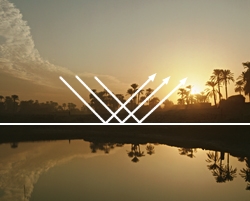DK Science: Reflection
Reflections are usually caused by shiny things, such as MIRRORS, that show a reversed image of whatever is placed in front of them. The image seems to be as far behind the mirror as the object is in front of it. Not only mirrors make reflections, however. Most objects reflect some of the light that falls on them. In daytime we see familiar objects like grass, trees, and the sky only because they reflect light from the Sun into our eyes.

When light rays bounce off a completely smooth surface, such as a still pool of water, a mirror, or even something like a shop window, we are able to see a very clear reflection on the surface. Every ray of light is reflected perfectly from the surface and bounces back in a regular way. The reflected image is very clear and sharp.
A rough surface, such as this rippling pond, causes light rays to bounce off it in many different directions. It may still be possible to make out an image on the surface, or, if it is very rough, the image is very broken up. Most objects reflect light in this irregular way. Although we can see them, we cannot see any images reflected in their surfaces.
A mirror is a very smooth, highly polished piece of metal or plastic that reflects virtually all the light that falls onto it. The reflection appears to be behind the mirror and may look bigger, smaller, or the same size as the thing it is reflecting, depending on the mirror’s shape. We use mirrors when checking our appearance or driving. They also play an important part in telescopes, microscopes, cameras, and other optical (light-based) instruments.

A convex mirror curves or bends outwards and makes an object look smaller and further away than it actually is. It makes light rays seem to come from a point behind the mirror, further from our eyes. Things look smaller, but convex mirrors are helpful because they can show a wider picture or field of view.
A concave mirror curves or bends inwards and makes an object look bigger and nearer than it actually is. It works by making light rays seem to come from a point in front of the mirror, which is closer to our eyes. Concave mirrors are important in such things as bicycle reflectors and reflecting telescopes.

This man is shaving with the help of a concave mirror. Its curved surface makes the man’s face seem closer to him than it really is. The reflected image he sees is magnified and he can easily see what he is doing. The mirror’s drawback is that less of the man’s face fits into the mirror than in a flat mirror of the same size.
Drivers use mirrors to see traffic coming up behind them. It is important for drivers to see as much of the road behind as they can, so wing mirrors and rear-view mirrors are convex. A drawback is that they make vehicles on the road behind look smaller and further away than they would in a flat mirror of the same size. Drivers must remember that the vehicles are nearer than they appear.
